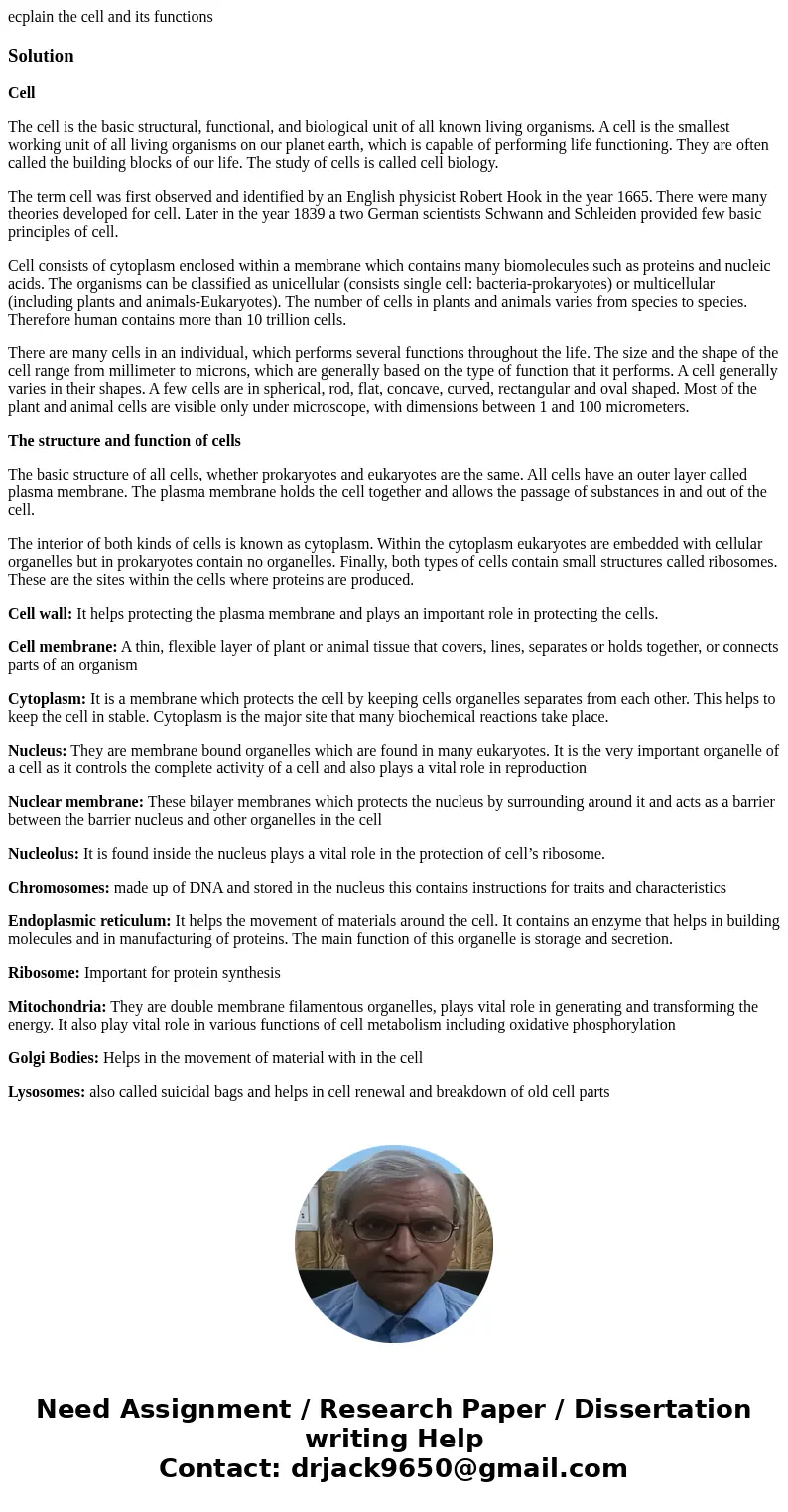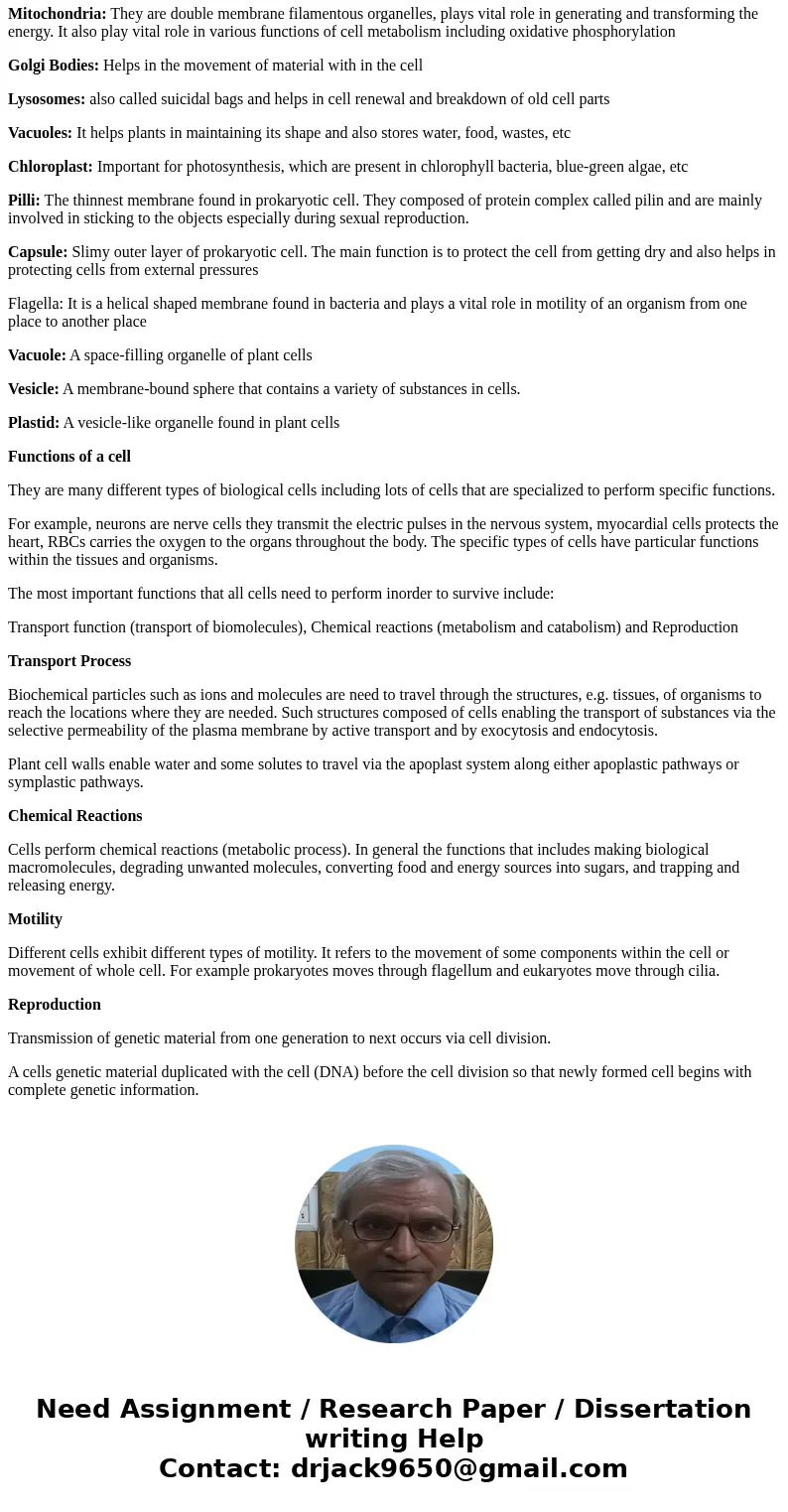ecplain the cell and its functionsSolutionCell The cell is t
ecplain the cell and its functions
Solution
Cell
The cell is the basic structural, functional, and biological unit of all known living organisms. A cell is the smallest working unit of all living organisms on our planet earth, which is capable of performing life functioning. They are often called the building blocks of our life. The study of cells is called cell biology.
The term cell was first observed and identified by an English physicist Robert Hook in the year 1665. There were many theories developed for cell. Later in the year 1839 a two German scientists Schwann and Schleiden provided few basic principles of cell.
Cell consists of cytoplasm enclosed within a membrane which contains many biomolecules such as proteins and nucleic acids. The organisms can be classified as unicellular (consists single cell: bacteria-prokaryotes) or multicellular (including plants and animals-Eukaryotes). The number of cells in plants and animals varies from species to species. Therefore human contains more than 10 trillion cells.
There are many cells in an individual, which performs several functions throughout the life. The size and the shape of the cell range from millimeter to microns, which are generally based on the type of function that it performs. A cell generally varies in their shapes. A few cells are in spherical, rod, flat, concave, curved, rectangular and oval shaped. Most of the plant and animal cells are visible only under microscope, with dimensions between 1 and 100 micrometers.
The structure and function of cells
The basic structure of all cells, whether prokaryotes and eukaryotes are the same. All cells have an outer layer called plasma membrane. The plasma membrane holds the cell together and allows the passage of substances in and out of the cell.
The interior of both kinds of cells is known as cytoplasm. Within the cytoplasm eukaryotes are embedded with cellular organelles but in prokaryotes contain no organelles. Finally, both types of cells contain small structures called ribosomes. These are the sites within the cells where proteins are produced.
Cell wall: It helps protecting the plasma membrane and plays an important role in protecting the cells.
Cell membrane: A thin, flexible layer of plant or animal tissue that covers, lines, separates or holds together, or connects parts of an organism
Cytoplasm: It is a membrane which protects the cell by keeping cells organelles separates from each other. This helps to keep the cell in stable. Cytoplasm is the major site that many biochemical reactions take place.
Nucleus: They are membrane bound organelles which are found in many eukaryotes. It is the very important organelle of a cell as it controls the complete activity of a cell and also plays a vital role in reproduction
Nuclear membrane: These bilayer membranes which protects the nucleus by surrounding around it and acts as a barrier between the barrier nucleus and other organelles in the cell
Nucleolus: It is found inside the nucleus plays a vital role in the protection of cell’s ribosome.
Chromosomes: made up of DNA and stored in the nucleus this contains instructions for traits and characteristics
Endoplasmic reticulum: It helps the movement of materials around the cell. It contains an enzyme that helps in building molecules and in manufacturing of proteins. The main function of this organelle is storage and secretion.
Ribosome: Important for protein synthesis
Mitochondria: They are double membrane filamentous organelles, plays vital role in generating and transforming the energy. It also play vital role in various functions of cell metabolism including oxidative phosphorylation
Golgi Bodies: Helps in the movement of material with in the cell
Lysosomes: also called suicidal bags and helps in cell renewal and breakdown of old cell parts
Vacuoles: It helps plants in maintaining its shape and also stores water, food, wastes, etc
Chloroplast: Important for photosynthesis, which are present in chlorophyll bacteria, blue-green algae, etc
Pilli: The thinnest membrane found in prokaryotic cell. They composed of protein complex called pilin and are mainly involved in sticking to the objects especially during sexual reproduction.
Capsule: Slimy outer layer of prokaryotic cell. The main function is to protect the cell from getting dry and also helps in protecting cells from external pressures
Flagella: It is a helical shaped membrane found in bacteria and plays a vital role in motility of an organism from one place to another place
Vacuole: A space-filling organelle of plant cells
Vesicle: A membrane-bound sphere that contains a variety of substances in cells.
Plastid: A vesicle-like organelle found in plant cells
Functions of a cell
They are many different types of biological cells including lots of cells that are specialized to perform specific functions.
For example, neurons are nerve cells they transmit the electric pulses in the nervous system, myocardial cells protects the heart, RBCs carries the oxygen to the organs throughout the body. The specific types of cells have particular functions within the tissues and organisms.
The most important functions that all cells need to perform inorder to survive include:
Transport function (transport of biomolecules), Chemical reactions (metabolism and catabolism) and Reproduction
Transport Process
Biochemical particles such as ions and molecules are need to travel through the structures, e.g. tissues, of organisms to reach the locations where they are needed. Such structures composed of cells enabling the transport of substances via the selective permeability of the plasma membrane by active transport and by exocytosis and endocytosis.
Plant cell walls enable water and some solutes to travel via the apoplast system along either apoplastic pathways or symplastic pathways.
Chemical Reactions
Cells perform chemical reactions (metabolic process). In general the functions that includes making biological macromolecules, degrading unwanted molecules, converting food and energy sources into sugars, and trapping and releasing energy.
Motility
Different cells exhibit different types of motility. It refers to the movement of some components within the cell or movement of whole cell. For example prokaryotes moves through flagellum and eukaryotes move through cilia.
Reproduction
Transmission of genetic material from one generation to next occurs via cell division.
A cells genetic material duplicated with the cell (DNA) before the cell division so that newly formed cell begins with complete genetic information.


 Homework Sourse
Homework Sourse